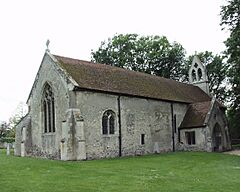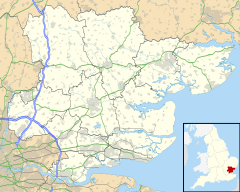Little Chesterford facts for kids
Quick facts for kids Little Chesterford |
|
|---|---|
 Little Chesterford church |
|
| Population | 215 (2011) |
| OS grid reference | TL515415 |
| Civil parish |
|
| District |
|
| Shire county | |
| Region | |
| Country | England |
| Sovereign state | United Kingdom |
| Post town | Saffron Walden |
| Postcode district | CB10 |
| Dialling code | 01799 |
| Police | Essex |
| Fire | Essex |
| Ambulance | East of England |
| EU Parliament | East of England |
| UK Parliament |
|
Little Chesterford is a small village in Essex, England. It's located in the East of England, close to the Cambridgeshire border. The village is built along a sunken lane, next to a small chalk stream that flows into the River Cam.
Little Chesterford is about 1 km (0.6 miles) southeast of Great Chesterford. It's also about 5 km (3 miles) northwest of Saffron Walden. A tiny group of houses called Springwell is just south of the village.
East of the village, up a hill, is Chesterford Park. This area has a large house from the mid-1800s. It's part of a 100-hectare (250-acre) estate. Today, this estate is a science park called Chesterford Research Park. The area around the village has rolling hills and wide views. The land is mostly used for farming.
The church, manor house, and village hall are at the heart of Little Chesterford.
Contents
Exploring St Mary's Church
The church of St Mary was built in the early 1200s. It still looks much like it did back then. It has a long main area (nave) and a chancel (the part where the altar is) under one roof.
Inside, you can see a simple screen from the 1400s. There's also a restored monument to James Walsingham from 1728. It was an early work by a famous artist named Henry Cheere. Another interesting feature is a special brass plaque for George and Isabel Langham from 1462.
The church was repaired in the 1800s. A small room (vestry) was added. A bell-cot for two bells was also built at the west end of the church.
Discovering the Manor House
The manor house also dates back to the 1200s. It is one of the oldest homes in Essex that people still live in. It was built in three stages. First, a timber-framed hall was built in the mid-to-late 1200s. Then, a wing for the family's private rooms was added. An even older stone building from the early 1200s was turned into a service wing.
Today, the manor house looks like a classic H-shaped building. It still has many of its original stone and wooden parts.
Other Interesting Buildings
The old school building was built in 1862 for 24 children. It closed by 1902. This building is a good example of a Victorian school. It was later used as a Sunday school and is now the village hall.
Across from the hall is a house from the 1500s. It was once a large hall house. Later, floors were added, and a fireplace blocked the main hallway. You can still see the frame of the original front door. More timber-framed houses are located up the village towards the Saffron Walden road.
A small brick bridge crosses the River Cam. It was built in 1791. This bridge replaced an older one from the 1500s. It marks the western edge of the village.
A Look Back: Little Chesterford's History
Little Chesterford has always been a small village. The oldest signs of people living here are from the Neolithic period (New Stone Age). These remains were found west of the village. Tools from the Bronze Age and Iron Age have been found in Chesterford Park.
The name 'Chester' often means there was a Roman fort nearby. The main Roman fort and river crossing were at Great Chesterford. However, signs of at least three Roman-British farmsteads have been found in Chesterford Park.
A manor called Manhall once stood in the Chesterford Park area. This manor house was no longer used by the 1600s and fell apart. Some old records suggest a castle might have been built here in the 1200s.
How the Population Has Changed
The number of people living in Little Chesterford hasn't changed much over time. The Domesday Book from 1086 listed about 27 households. This suggests a total population of just over 100 people.
The first national count (census) in 1801 recorded 120 people. The population reached its highest point in 1861, with 276 people. In the 2011 census, the population was 215.
The village's physical size has also stayed mostly the same since 1810. The only major change was about 20 houses added on the Saffron Walden road in the mid-1900s.
Chesterford Park's Journey
From the 1500s until 1840, Chesterford Park was a very large farm estate. It covered about 3,200 acres (13 km²). Many important people owned it over the years. These included Sir Thomas Audley and Lord Inchcape.
After World War II, the site became a research and development center. Companies like Boots and Fisons used it. Later, it was developed into a Science Park. In 2017, the local council bought a 50% share in the park.
Major Events in the 20th Century
Two big events in Little Chesterford made national news in the 1900s:
- The Village Fire of 1914: On April 7, 1914, a spark likely from a steam engine started a fire. The wind quickly spread the fire from one thatched roof to another. In less than four hours, two farms, two pubs, and nine homes were destroyed. Forty-three people lost their homes, which was about 20% of the village's population. The mix of old and new houses in the village today shows the impact of this disaster. You can watch a short film about the fire's aftermath.
- Explosion at Chesterford Park in 1944: When World War II began in 1939, Chesterford Park was taken over by the government. The mansion became a hospital, and the grounds were used to store ammunition. On May 30, 1944, the ammunition dump exploded in a series of huge blasts. People heard the explosions over 40 kilometers (25 miles) away. Windows were blown out for miles around. The village and hospital were evacuated, but luckily, no one was seriously hurt. The Chesterford Park mansion was never used as a home again after this event.
Fun and Community in Little Chesterford
The village community holds several traditional English events each year.
- Easter Egg Hunt: This is always held on Easter Saturday afternoon.
- Village Fete: Usually on the second Saturday of June. It has classic games like "splat the rat" and "coconut shy." There are also stalls selling cakes, plants, books, and toys. Live music and steam engine rides add to the fun.
- Bonfire Night: Always on November 5th. This event includes a bonfire, fireworks, food, and drinks.
In recent years, special parties have been held for big events. These include the 100-year anniversary of the Great Fire (2014), the Queen's Diamond Jubilee (2013), and the Queen's 90th birthday (2016).
Little Chesterford and its neighbor, Great Chesterford, produce a monthly newsletter called the Chesterford Broadsheet. It's given to every home for free. A mobile library from Saffron Walden visits Little Chesterford every two weeks.
Village Governance
Little Chesterford is part of the Chesterfords electoral ward. This means it's part of a larger area that votes for local representatives. In 2011, the total population of this ward was 1,709 people.
Getting Around: Transport
Little Chesterford is about 3 km (1.8 miles) from junction 9 of the M11 motorway. The village has a bus service called Stagecoach East bus route Citi 7. Great Chesterford railway station is just a kilometer away. From there, you can catch trains to Cambridge and London Liverpool Street.
The ancient path known as the Icknield Way passes within a kilometer of the village.


